Best Hockey Training: 7 Off-Ice Exercises For Optimal Performance
When you're a young beginner, your hockey training goals are simple and over several years, you'll develop these skills on the ice.
With time, however, you'll realize you need to get stronger and faster.
Hockey will only continue to become more and more physical.
On the ice, it's survival of the fittest. You'll get hit, and you'll land some, too.
But to advance your hockey training, you must include off-ice exercises to build a strong, resilient body.
IMPROVE YOUR HOCKEY TRAINING AT HOME WITH POLYGLIDE SYNTHETIC ICE
Off-ice training enhances your physical attributes, making you better prepared to handle the game's demands.
Incorporating a well-rounded off-ice training program can improve your sports performance and longevity.
These 7 simple off-ice exercises will help you pack on muscle, build functional strength, and improve your performance on the ice.
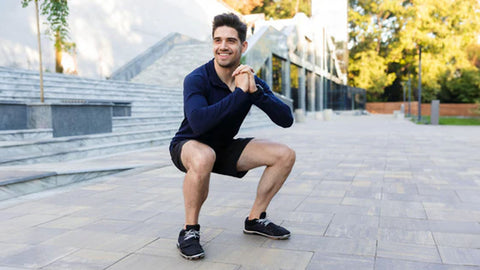
1. Squats: Build Lower Body Strength and Power
Squats are a highly effective exercise for building lower body strength and power.
They help target multiple muscle groups, including the quads, hamstrings, and glutes, which can improve overall leg strength and power for hockey players.
Perform squats by standing straight with your feet slightly wider than shoulder-width apart.
You drive your hips back and bend your knees, lowering the butt past the knees and getting as deep as possible.
Come back to the starting position to complete one rep.
Squats also help improve joint stability and mobility.
They are functional exercises that mimic movements we perform in ice skating.
This makes them essential for maintaining proper biomechanics and preventing injury.
Squats can be modified to suit your fitness level and goals, and incorporating weight or plyometric variations can help increase your workout's intensity.
You can start with a goblet squat using a single heavy dumbbell, then transition to barbell squats.
Increase the weight and repetitions based on your trainer's recommendation or personal goals.
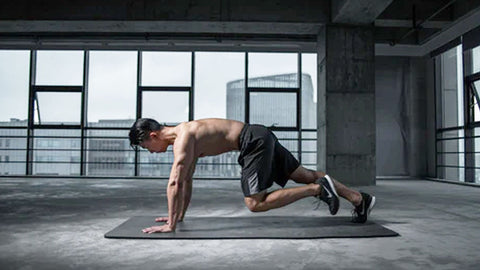
2. Planks: Strengthen Core Muscles for Stability on the Ice
Strengthening your core muscles is crucial for stability, balance, and overall performance in ice sports such as ice hockey.
The plank exercise is considered one of the most effective ways to develop your core muscles.
Planks are a static exercise that involves holding a push-up position on your forearms with your body straight from head to heels.
Holding a plank in 60-90-second intervals is ideal for beginners. Increase the length and intensity of the plank over time.
They are simple yet highly efficient and effective, targeting the abdomen, lower back, and shoulder muscles simultaneously.
Planks also help improve overall posture and alignment, essential for maintaining balance and stability on the ice.
3. Medicine Ball Exercises: Enhance Upper Body Strength and Coordination
Medicine ball throws are a beneficial exercise for athletes and non-athletes alike.
The exercise targets multiple muscle groups in the upper body, builds strength and endurance, and improves coordination and proprioception, enhancing the ability to perform complex movements more efficiently and accurately.
Some example exercises:
- You can perform wall balls, throwing and catching the ball as high as possible against a wall.
- Slam the ball against a wall or on the floor from an overhead stance.
- Pick it up from the floor and release it over one shoulder, then repeat with the other.
- If you're working out with a friend, throw it to each other. You can also sit back to back and pass it to each other from one side to the next.
Don't have a medicine ball? You can get an inexpensive option on Amazon, like the Yes4All Slam Ball.
These dynamic movements require power, speed, and accuracy, making it an excellent addition to any fitness routine.
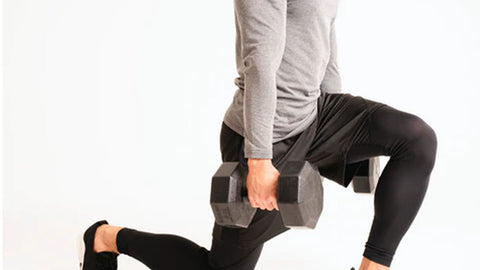
4. Lunges: Improve Balance and Agility
When you get body-checked, you want to quickly recover from falls (or avoid falling altogether).
We'll continue the list with lunges to build strength in the lower body.
Lunges are a time-tested exercise used for centuries to improve balance and agility.
This simple yet effective movement targets multiple muscle groups, including the quadriceps, hamstrings, glutes, and core, making it a valuable addition to any exercise routine.
The primary benefits of lunges include improving balance and agility and preventing injuries by strengthening the knee and hip muscles.
You can perform lunges with added weight, like a kettlebell, dumbbells, or a barbell.
Stand upright with your feet slightly apart.
Take a large step (lunge) forward (or backward) and bend your knee, lowering your body until the back knee points to the floor.
Return to the starting position and repeat with the opposite leg.
Lunges are an excellent way to increase movement speed and efficiency, making us more agile in sports and everyday activities.
With many variations of lunges available, we can target different muscle groups and challenge our balance and agility in new ways.
5. Jump Rope: Increase Cardiovascular Endurance and Foot Speed
Jump rope is a simple yet effective exercise that can be done almost anywhere with minimal equipment.
It is a versatile workout with many benefits, including improved cardiovascular health, increased agility and speed, and enhanced balance and coordination.
Jumping rope at a moderate to high intensity can elevate your heart rate and work your cardiovascular system, helping to build stamina and endurance over time.
Your rope of choice also matters:
- Sonic Boom M2 High-Speed Jump Rope focuses on stamina and agility.
- HPYGN Weighted Jump Rope adds power, strengthens your arms, and increases calorie burn.
Regular jump rope practice can enhance speed, agility, balance, and coordination. Its low-impact nature is gentle on the joints, making it an excellent option for individuals of all fitness levels.
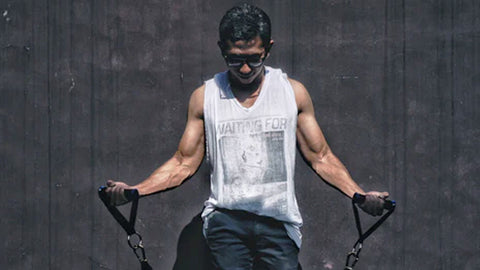
6. Resistance Band Exercises: Target Specific Muscle Groups for Hockey Movements
You can perform almost any exercise using resistance bands.
Resistance band exercises improve muscle strength, power, and explosiveness, which are crucial for ice hockey performance.
These exercises can help target specific muscle groups important for ice hockey movements, including the quadriceps, hamstrings, glutes, hip flexors, calves, core, and upper body muscles such as the shoulders and back.
Players can improve their performance on the ice by incorporating resistance band exercises into their training routine.
A set like the Gymreapers Resistance Bands are perfect for any skill level.
Effective exercises include the resistance band squat, hip flexor exercise, and resistance band calf raise for lower body strength, as well as the resistance band plank, resistance band rows, and resistance band shoulder press for core and upper body muscles.
7. Burpees: Full-body Exercise for Conditioning and Explosiveness
It's considered the best exercise ever. Burpees are a popular full-body exercise that combines a squat, push-up, and jump, effectively targeting multiple muscle groups simultaneously.
It is an efficient and effective way to improve overall physical fitness, including cardiovascular endurance, lung capacity, aerobic fitness, strength, muscle tone, agility, coordination, explosiveness, and power.
Burpees can quickly elevate your heart rate, helping to improve cardiovascular health and stamina.
The continuous and dynamic nature of the exercise helps improve lung capacity and overall aerobic fitness.
It is also an excellent exercise for building strength and muscle tone, engaging the quadriceps, hamstrings, glutes, chest, shoulders, triceps, calves, and core muscles.
The quick transitions between the squat, push-up, and jump require coordination and balance, helping to enhance overall body awareness and control.
This can be particularly beneficial for athletes who rely on quick and precise movements in their sport.
The explosive jump at the end of the movement helps develop fast-twitch muscle fibers responsible for quick and powerful movements, making it an excellent exercise for athletes in sports that require quick bursts of energy.
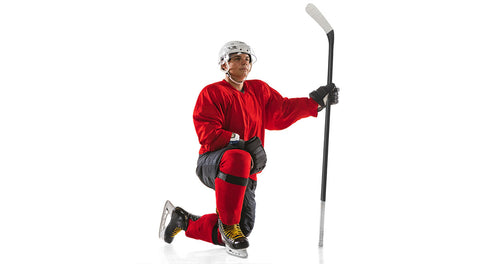
Off-ice Exercises to Elevate Hockey Performance
Incorporating off-ice exercises into a hockey player's training routine can offer several benefits, such as improving overall fitness, building strength and power, enhancing agility and flexibility, and reducing the risk of injury.
These 7 exercises are foundational and should be part of a well-rounded workout routine that suits your age, strength, and fitness goals.
Adding running, cycling, circuit training, and HIIT exercises can help improve cardiovascular endurance and anaerobic fitness.
Strength training exercises such as deadlifts, push-ups, and pull-ups can help develop lower and upper body strength.
Plyometric exercises like box jumps, lateral hops, and burpees can improve agility and quickness.
Off-ice exercises can strengthen the muscles and connective tissues that support the joints, helping players reduce the risk of common hockey injuries such as sprains, strains, and overuse injuries.
Best of all, it helps you build the strength necessary to impose your will, body-check your opponent as needed, and dominate for years to come.




